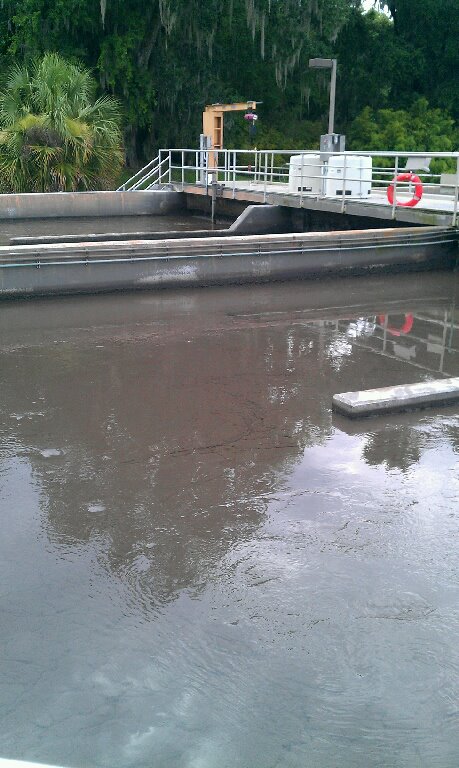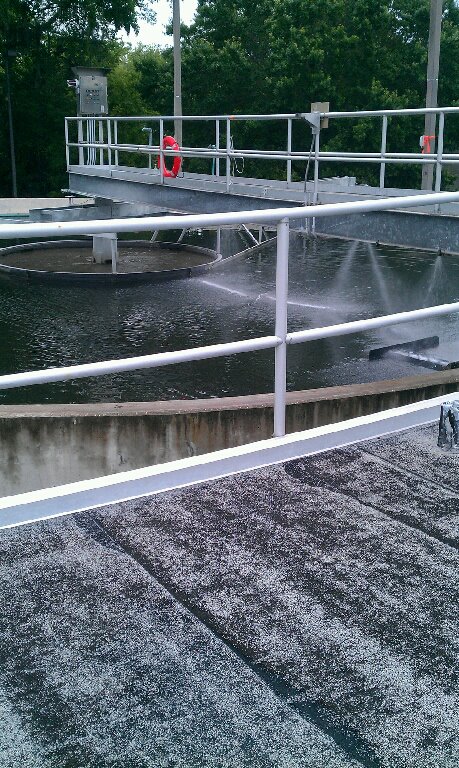University of Florida Water Reclamation Facility
June 15, 2012
Gainesville, FL
Author: Henry Legett
Website

Since 1948 the University of Florida has treated its own wastewater. The current treatment system works off of a BioDenipho process, in which the system focuses mainly on the biological removal of nitrogen and phosphorus. The purpose of this trip was to learn about the current method of wastewater management. At the beginning of the tour each intern was given a copy of the treatment process. A descriptive summary of the process drawn from both the notes and our tour is outlined below.
A Descriptive Walk-Through of the Water Reclamation Facility:
- Referred to as the “Head of the Plant”, the pretreatment process includes screening and grit removal. The trash (rags, plastics, etc.) and grit fall into a dumpster which is removed by GRU.
- Incoming flow is between 3 and 5 million gallons of wastewater/day. The plant was running at ~1.5 million gallons/day at the time of our visit.
- The water then moves to the phase for biological nutrient removal which consists of two separate identical paths:
- Anaerobic zone: wastewater is mixed with waste activated sludge and microorganisms from the sludge assimilate the biological nutrients from the wastewaters.
- Aerobic ditches (“mixed liquor”): area alternates between oxic and anoxic conditions. Algae samples were collected from an actively aerating tank.
- Second anoxic zone: Denitrification, nitrates created in the oxic zone are reduced to di-nitrogen gas by denitrifying microbes.
- Re-aeration zone: further N2 removal.
- The water then moves to the secondary clarification where the sludge (microbial biomass) is settled out. Multiple algae samples from the settling tank/clarifier were collected.
- The sludge is mixed with polymers for coagulation, belt pressed, and stored in a holding tank. This stored thickened sludge is picked up once a week by GRU where it is currently treated and field applied. A large sample of the waste activated sludge was collected.
- Water from the clarifier is sand filtrated to further remove particulate matter.
- Once out of the sand filter the water is still rich in iron and other minerals, which gives the water a yellow tint and stains the chlorine tank walls a brownish color.
- After sand filtration the water is run through a chlorine contact chamber.
- After the chlorine treatment the water is crystal clear and is stored in a holding tank to be used at the cogeneration plant, for campus irrigation, for fountain use, or to be deep well injected.


It is important to be informed about how your waste is managed, be it human waste at a wastewater treatment facility, or solid waste at a landfill. In developed nations, infrastructure has removed people from their waste to the point that people are ignorant as to the waste management process and the consequences of their actions when it comes to waste. While the current method of treatment was effective in doing what it was suppose to do, remove nutrients, it was interesting to see just how energy intensive and unsustainable the current system is. Millions of dollars are spent producing inorganic nitrogen fertilizers for food, and millions of dollars are spent removing these same nutrients from the wastewater and releasing them into the atmosphere. It is easy to see how developing a system to reclaim these nutrients from the water to again be used as fertilizer, effectively creating a closed cycle, could have huge implications from a sustainability standpoint.